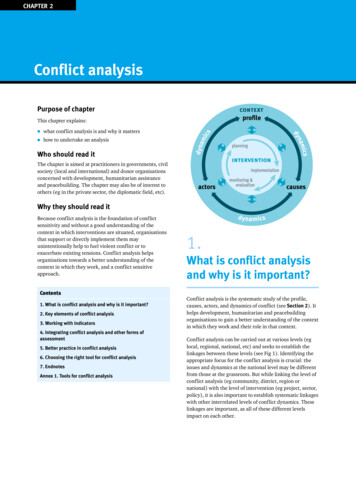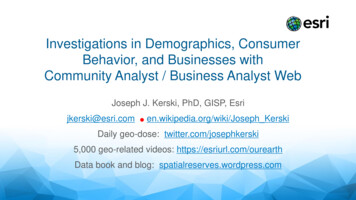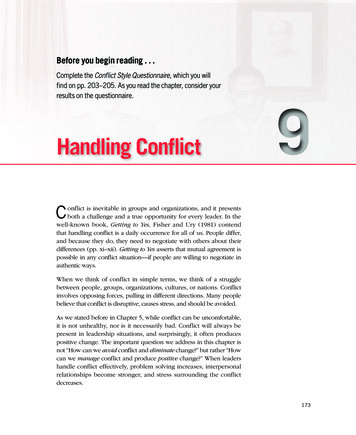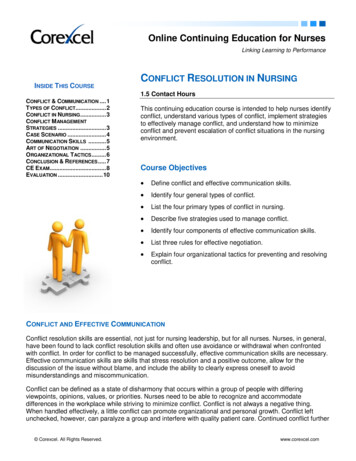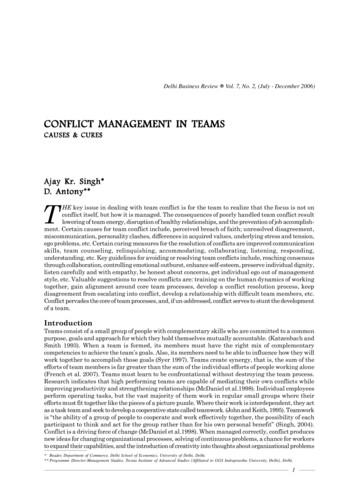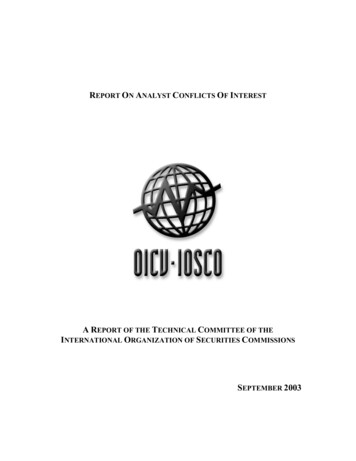
Transcription
REPORT ON ANALYST CONFLICTS OF INTERESTA REPORT OF THE TECHNICAL COMMITTEE OF THEINTERNATIONAL ORGANIZATION OF SECURITIES COMMISSIONSSEPTEMBER 2003
REPORT ON ANALYST CONFLICTS OF INTERESTIn order to examine the issues that must be considered by securities regulatorsin addressing conflicts faced by analysts, the IOSCO Technical Committeeestablished and directed the Analyst Project Team to: assess in the constituent jurisdictions1 (the “Jurisdictions”) the actualand perceived conflicts of interest that confront sell-side analysts andthe firms that employ them; survey the existing rules, industry practices, and professional standardsthat address issues related to analyst conflicts of interest in theJurisdictions; assess the means available to regulatory authorities for addressing theconflicts confronting analysts; and determine whether, and in what form, IOSCO should make anystatements addressing the conflicts of interest faced by analysts.The Analyst Project Team conducted an extensive survey in the Jurisdictionsthe results of which are discussed in this Report. As well, this Report explores theconflicts of interest analysts employed by firms face and the measures in place orproposed in the Jurisdictions to address these conflicts as of December, 2002.The Report of the Project Team to the Technical Committee addressed theTechnical Committee’s mandate and discussed future directions and proposed that aset of high-level principles be developed as a next stage. This proposal led to theTechnical Committee’s adoption of the IOSCO Statement of Principles forAddressing Sell-Side Securities Analyst Conflicts of Interest approvedcontemporaneously with this Report. Contemporaneously with the adoption of itsStatement of Principles, the Technical Committee also endorsed the Project Team’sreport as a report of the Technical Committee. The report of the Project Team to theTechnical Committee follows:1The Project Team was chaired by Mr. Tatsuya Kanai of the Financial Services Agency of Japan.Members of the Project Team included: Commission des valeurs mobilières du Québec, Québec,Canada; Ontario Securities Commission, Ontario, Canada; Commission des Operations de Bourse,France; Bundesanstalt für Finanzdienstleistungsaufsicht, Germany; Securities and FuturesCommission, Hong Kong; Commissione Nazionale per le Societa e la Borsa, Italy; Financial ServicesAgency, Japan; Comissão do Mercado de Valores Mobiliários, Portugal; Comisión Nacional delMercado de Valores, Spain; Swiss Federal Banking Commission, Switzerland; Commodity FuturesTrading Commission, United States of America; Securities and Exchange Commission, United Statesof America; Financial Services Authority, United Kingdom and Australian Securities and InvestmentCommission.
I.INTRODUCTIONInformation is the lifeblood of modern capital markets. The flow of timely andaccurate information among market participants promotes investor confidence in themarkets, which aids in the flow of capital to businesses. However, the volume andcomplexity of information and raw data which is available – including, issuerdisclosure statements, economic and employment statistics from governments, andmarketing and purchasing trend reports from private sources – can often beoverwhelming and confusing for investors. As a result, research analysts play animportant role in the relationship between companies and investors, both retail andinstitutional. Research analysts study companies and industries, analyze the disparateraw data, and often make forecasts and recommendations about whether to buy, sellor hold securities. Investors often view analysts as experts on and important sourcesof information about the securities they cover and rely on their advice.However, analysts (also referred to in this Report as securities analysts or sellside analysts) employed by full-service investment firms2 often face conflicts ofinterest that can interfere with the objectivity of their analysis. Conflicts arise becausethese firms (“firms” means in this Report full-service investment firms unlessotherwise stated) often undertake many, potentially conflicting, roles – for example,firms may act as retail brokerage houses for individuals wishing to purchase or sellsecurities, while at the same time offering underwriting services to issuers of thosesecurities – and research analysts are often called upon to assist with these conflictingactivities. If an analyst’s firm’s activities place the analyst in conflict situations – forexample, if the analyst has powerful financial incentives to direct clients towardsspecific securities, or if the analyst’s job security depends on dissuading clients fromselling certain shares – the advice the analyst offers may no longer be objective.These conflicts risk eroding investor confidence in research and, potentially, themarkets as a whole if not adequately addressed.Two of IOSCO’s three core objectives are “the protection of investors” and“ensuring that markets are fair, efficient and transparent.”3 The integrity andobjectivity of research provided to investors is crucial to promoting these objectives.The integrity of an analyst’s research can only be achieved if situations of potentialconflicts of interest4 are avoided as much as possible and, if not avoidable, properlymanaged and disclosed to investors.This Report is structured as follows:Section I – Introduction.Section II – Discussion of the types of activities performed by analystsemployed by firms in the Jurisdictions.2The term “full-service investment firm” as used in this Report is intended to refer to entities thatprovide a variety of financial and financial-related services to clients. In some Jurisdictions suchentities may be referred to as broker-dealers, sell-side firms, banking groups or multi-service firms.3See IOSCO, Objectives and Principles of Securities Regulation (Sept. 1998).4In this report, the words “conflict” or “conflicts” refer to a conflict of interest or conflicts of interest.2
Section III – Discussion of the types of conflicts of interest faced by analystsand their firms.Section IV – Description of certain statutes, rules and regulations that theJurisdictions have designed to address conflicts of interest faced by analysts and theirfirms.Section V – Discussion of the key issues facing securities regulators inaddressing analyst conflicts of interest.II.SELL-SIDE ANALYSTSA.Types of AnalystsSell-side analysts historically have served an important role in the markets,promoting efficiency by compiling publicly available information and offeringanalysis and insights on companies and industries. The term analyst encompassesindividuals with varying functions within the securities industry. Analysts aregenerally classified into one of three broad categories depending on the nature of theiremployment: sell-side, buy-side and independent.Sell-side analysts are the focus of this Report.5 They are typically employedin the research department of full-service investment firms. Analysts on the sell-sidetypically publish research reports on the securities of companies or industries that theycover. These research reports are distributed to customers of the firm and ofteninclude a specific recommendation – such as a recommendation to buy, hold, or sellthe subject security – and often include the analyst’s expectation of the future priceperformance of the security (“price target”). As will be discussed in this Report, sellside analysts often perform functions other than producing research. Many analystswork for firms that also provide investment banking services for corporate clients –including clients whose securities the analysts cover.6Unlike sell-side analysts, buy-side and independent analysts typically are notassociated with firms that underwrite the securities they cover and generally have few,if any, other conflicts that could impair the objectivity of their research.Buy-side analysts generally work for money managers – such as mutual funds,hedge funds, pension funds, or investment advisers – that purchase and sell securities5The potential for conflicts of interest is not limited solely to sell-side analysts; buy-side andindependent analysts may also encounter conflicts. The Project Specification, however, instructed theProject Team to focus on sell-side research in order to conclude the project within a reasonable period.Moreover, sell-side research has the biggest impact on retail and small institutional investors, and sellside analysts face numerous conflicts of interest. Among other things, the second stage of this projectcan consider whether to review conflicts that pertain to other types of analysts.6Some firms that have discontinued their investment banking operations now market themselves asmore independent than full-service investment firms, emphasizing their relative lack of conflicts ofinterest.3
for their own investment accounts or on behalf of others. Buy-side analysts counseltheir employers about which securities they should buy, hold or sell and their researchis usually not distributed to anyone but the employer. For buy-side analysts, successor failure is a function of the accuracy and value-added nature of their analysis; buyside analysts are successful if their analysis results in good performance for theiremployers’ accounts. Thus, their interests’ generally are perceived to be more alignedwith those of the money managers they work for and those of their clients.Independent analysts work for research originators or boutiques that are legalentities separate from full-service investment firms and sell their research to others ona subscription or other basis. Because their research is sold, and because thisconstitutes their unique or main source of income, independent analysts have a strongincentive to produce objective analysis for the subscribers of their company’sresearch.There are other entities that provide research, such as, newspapers, consensusinstruments and consolidators of information (such as Multex.com Inc.) but thisReport does not address such research.B.Activities Performed by Sell-Side AnalystsSell-side analysts provide clients with analysis and investmentrecommendations. Their work is often disseminated in written research reports thatinclude their analysis and recommendations on whether to buy, sell or hold a securityand often include target prices for securities. Research is often provided by a firm aspart of a package of services to clients in return for trading commissions directed tothe firm. Research information is often provided to clients indirectly through thefirm’s salespeople who have direct contact with clients.In recent years, analysts have become involved in other services provided byfirms in addition to research. Some Jurisdictions report that the other services sellside analysts provide to firms include: supporting the firm’s investment banking department; assisting in securities marketing efforts; providing help to the firm’s investment management department; and giving presentations to the firm’s sales and trading staff.1. Investment Banking Support. Most Jurisdictions report that sell-sideanalysts are often brought over the “Chinese Wall”7 that separates their firms’7A “Chinese Wall” is an internal structure aimed to ensure physical and/or informational separationamong the departments of a full-service investment firm to prevent the circulation of “insideinformation.” Crossing “over the wall” refers to a situation where an analyst in the researchdepartment is formally brought over the informational barrier that exists between the research andinvestment banking departments and is temporarily considered part of the investment banking unit.The head of the research department and/or head of the legal and compliance department must usuallyapprove such instances of wall-crossing by analysts. In some Jurisdictions, while an analyst is over the4
research department from other departments to add their expertise to corporatefinance transactions. These duties may include evaluating prospective investmentbanking clients and performing “due diligence” examinations. Analysts may alsoattend marketing meetings with their investment bank colleagues that are intended topersuade a prospective client to use the firm’s banking services. Indeed, issuers mayaward investment banking business to firms based on the reputation and stature of thefirm’s analysts. Several Jurisdictions have noted that analysts may also generate ideasfor corporate transactions for the investment banking department.2. Securities Marketing. In some Jurisdictions, analysts may be involved inmarketing, and even selling, securities that they cover to institutional investors. Forexample, they may assist investment bankers during “road shows” where they makemarketing presentations to potential institutional investors.3. Investment Management Assistance. In some Jurisdictions, analysts assisttheir firms’ investment management departments in evaluating transactions.4. Presentations to Sales and Trading Staff. Analysts sometimes provideinternal presentations and briefing sessions to their firms’ sales staff and trading staffconcerning the securities they cover. These analyst presentations are meant toprovide staff in the sales and trading departments with background and overviewconcerning current events and company announcements.C.Analyst Qualifications and Registration RequirementsMost Jurisdictions report that, currently there is no particular set of minimumqualifications or particular registration required to work as a securities analystconducting strictly research activities. In only one Jurisdiction was an analystrequired to pass an examination testing the analyst’s general industry and regulatoryknowledge. Regulators in another Jurisdiction recently proposed a new registrationcategory and corresponding qualification examination for research analysts.Despite the general lack of specific qualification or registration requirements,several Jurisdictions note that it is common for analysts to possess some combinationof a post-graduate degree, certain professional qualifications (such as a CFA (certifiedfinancial analyst) or CPA (certified public accountant) certification), and to havesome experience in the industry they cover.Securities analysts may incur other qualification requirements if their positionwithin the firm entails certain other obligations (in addition to their researchactivities), such as a managerial responsibility or client interaction. In certainJurisdictions, analysts that meet with customers or publish their name and contactinformation in a research report are required by self-regulatory organization (“SRO”)rules to pass an examination for general securities representatives.ThoseJurisdictions also report that analysts who act in a supervisory capacity and approvewall and for a certain period thereafter, an analyst is not permitted to write a research report on thesubject issuer, since the analyst is considered part of the banking team and therefore possibly privy toinside information.5
research reports for distribution must pass an examination for supervisory analystsand be deemed sufficiently experienced or “fit and proper.”Several Jurisdictions report that analysts may voluntarily opt to takeexaminations administered by industry groups or professional analyst associations asa condition of membership in these organizations. However, in many Jurisdictions,passing such an examination is not itself a qualification to work as an analyst, andmembership in such associations is often voluntary.Most Jurisdictions do not require that analysts’ qualifications or backgroundsbe specifically disclosed. However, some SROs and analyst associations makequalifications of analysts available on websites. Likewise, some firms publish theiranalysts’ curriculum vitae along with their research reports.D.Oversight of Sell-Side Analysts and Full-service Investment FirmsOversight of analysts is complex, layered, and varies by Jurisdiction.Generally, the conduct and professionalism of sell-side analysts is monitored andsupervised by one or more of: (1) the firms that employ the analysts; (2) selfregulatory organizations; (3) government regulators or other authorized securitiesregulatory authority; and (4) professional associations. Not all of these four types ofoversight are present in all Jurisdictions.8 The degree of oversight conducted by eachof these entities varies among Jurisdictions, and may even vary within a givenJurisdiction depending on the position and duties of a particular analyst.Complicating this picture, the depth of oversight by each of these entities andthe coordination among the oversight entities is currently under extensive examinationin several Jurisdictions. As discussed below, until recently most Jurisdictionsreported that there was little, if any, direct regulation of analyst conflicts at thestatutory or regulatory level; most oversight was performed at the firm or professionalassociation level. However, several Jurisdictions have recently enacted – or areconsidering – legislation at the statutory and/or regulatory level to address conflictsfaced by analysts.1. Internal Firm Rules. According to the survey, internal firm rules currentlyappear to have the largest role in addressing the conflicts of interest faced bysecurities analysts. In some of the Jurisdictions, laws and government regulationsrequire firms to be organized in such a way as to be able to address conflicts ofinterests faced by their employees (including analysts). For example, most firms haveinternal rules restricting analysts’ investments in the securities of the companies (andsectors) they review, or in firm clients.2. Self-Regulatory Organizations. In some Jurisdictions, analysts’ activitiesare overseen by SROs in the analysts’ capacity as employees of firms that aremembers of a SRO. These SROs have rules that their member firms must adhere toand that require the firms to adequately supervise securities analysts who work forthem. In some Jurisdictions, these rules tend to relate to full-service investment8In some Jurisdictions the securities regulatory authority is neither a SRO nor a government regulatorbut an independent body created by statute.6
firms’ employees generally and require firms to address all types of conflicts ofinterest that financial-sector employees may face. In others, these rules mayspecifically single out analysts and require member firms to address analyst conflictsof interest through specific internal supervisory procedures. These types of rules –and proposed rules currently being considered – are described in Section IV.3. Government Regulators. Although few Jurisdictions impose specificregulations on analysts, in most Jurisdictions analysts are subject to regulations orpolicies that may affect their activities, such as business conduct rules, best practices,principles for business, organizational requirements and laws prohibiting insiderdealing and the dissemination of false or misleading information. In many countries,the analyst needs to be approved or registered with a securities regulatory authority ifthe analyst trades with or advises clients. In most of the Jurisdictions, a securitiesregulatory authority is responsible for monitoring compliance with and enforcingadherence to the statutes, laws or regulations regarding analyst’s conflict of interestsas part of the conduct of firms.Most of the Jurisdictions surveyed had no statutes or regulations specificallyaddressing analysts’ conflicts of interests. However, one Jurisdiction recently issueda regulation directly concerning analysts and disclosure of conflicts of interest and, inanother Jurisdiction, regulations specifically dealing with disclosure of conflicts ofinterests of analysts have been passed by the national legislature. A more detaileddescription of the legislative and regulatory oversight currently in place and recentlyproposed in the Jurisdictions is contained in Section IV.4. Industry Groups and Professional Associations. Membership in certainindustry groups and professional associations require analysts to adhere to codes ofconduct and/or best practices, which are designed to enhance analyst integrity in theproduction of research. Some countries oblige the analyst to disclose in their reportsif they are members of an industry association or group. Many of these associationsstress the need to produce independent research and always act in the interests of theclient, and often require the members to observe standards of conduct in addition tothose required by statues, rules and regulations. Failure to abide by these codes mayresult in expulsion from the association. However, since membership in theseorganizations is voluntary and not a requirement to do business in most Jurisdictions,sanctions for violating these association codes are relatively limited.Several Jurisdictions have national professional associations that issue codesof conduct for their securities analyst members. Securities analysts or their firms inother Jurisdictions may belong to a “multinational” professional organization withmembership standards of conduct.III.CONFLICTS OF INTEREST FACING SELL-SIDE ANALYSTSSell-side analysts work in an environment with many inherent conflicts ofinterest and competing pressures. On the one hand, full-service investment firms wanttheir individual investor clients to be successful over time because satisfied long-terminvestors are a key to a firm's long-term reputation and success. An investmentresearch team that is well respected for its objective analysis and recommendations is,7
therefore, an important asset to a firm. At the same time, several factors can createpressure on an analyst’s objectivity. Non-research functions that sell-side analysts areoften required or requested to perform may create incentives to issuerecommendations that conflict with investors’ interests.A number of potential conflicts of interest faced by sell-side analysts in theJurisdictions have been identified. These conflicts generally arise as a result of: the various commercial activities pursued by full-service investment firms; analyst compensation arrangements; financial interests in covered companies held by analysts and their firms;and the reporting relationships within full-service investment firms.A.Conflicts Created by Services Provided by Full-Service InvestmentFirms and Proprietary TradingUnderstanding the importance of sources of income for full-service investmentfirms helps to identify and understand potential conflicts within these firms. Inparticular, the commercial requirements of investment banking activity, proprietarytrading by the firm and the provision of brokerage services may create conflicts ofinterest for analysts.1. Investment Banking Relationships. Providing investment bankingservices, such as underwriting an initial public offering (“IPO”) or advising clients onmergers or acquisitions, can be a lucrative source of revenue for full-serviceinvestment firms. Sell-side analysts at these firms may be inhibited from makingstatements or publishing research reports that could jeopardize existing or potentialclient relationships for their investment banking colleagues.Indeed, an analyst may be substantially involved with the investment bankingunit that takes a company public and thus be part of the “banking team.”Underwriters assisting a company with a public offering have a strong interest in thesuccess of the offering and the performance of the company’s securities in the postoffering period. An analyst assisting the investment bankers with a company’s publicoffering may be expected to issue research reports containing favorablerecommendations about the company’s securities.These conflicts can manifest themselves in variety of ways. For example, ananalyst may refrain from issuing a negative report against a company with whom hisor her firm has a relationship or he or she may publish research that presents the issuerin a positive light, but in fact does not accurately represent that analyst’s actualassessment of the issuer. An analyst may also cease to issue research altogether on aparticular company in order to avoid issuing a negative report. As well, the pressureto refrain from presenting a company in an unfavourable light can result in misleadingterminology being used in research reports.8
Analysts often use a variety of terms – buy, strong buy, near-term or long-termaccumulate, near-term or long-term over-perform or under-perform, neutral, hold – todescribe their recommendations. The meanings of these terms can differ from firm tofirm. In some cases, the use of these terms may involve a “code” for moresophisticated investors.For example, when an analyst issues a “hold”recommendation, retail investors understandably may believe this to mean arecommendation to maintain ownership of the security, whereas institutional investorsrecognize that the analyst is really recommending the sale of the securities. Thecoded terminology may be used to avoid making a negative statement about a presentor prospective investment banking client.In addition to confusing terminology, the research distribution channel at fullservice firms also may raise concerns. Some clients of a firm may enjoy a type of“preferred status” and receive notice of important information – including researchreports and intentions to issue an upgrade/downgrade – before the other clients of thefirm are informed of such information. One Jurisdiction expressed concernsregarding analysts distributing reports to banks or other companies with which thefirm does business, allowing these companies to buy and sell shares in anticipation ofthe report’s publication.2. Proprietary Trading and Discretionary Trading for Clients. Conflicts ofinterest may arise where a firm trades, for its own account or for clients, securities ofcompanies covered by the firm’s analysts. Firms may trade securities in companiescovered by their analysts for several reasons, such as market making (or otherliquidity provision), private equity investments, or portfolio management services forclients. Because research recommendations often have the ability to impact the priceof a company’s securities, analysts may be inclined to produce favorable reports andrecommendations in an attempt to maintain or boost the value of the securities held bythe firm, or its clients. Similarly, a firm may take advantage of pending research andposition themselves ahead of its publication, effectively “front-running” their ownrecommendations.3. Brokerage Services. An analyst's report can help his firm make moneyindirectly by generating the buying and selling of covered securities – which result incommission revenue for the firm.B.Financial Interests in Covered CompaniesA firm, its analysts and other employees may own significant positions in thecompanies the firm’s analysts cover. Analysts also may participate in employeestock-purchase pools that invest in companies they cover. In a recent trend called"venture investing," a firm, analyst, or colleagues may obtain discounted, pre-IPOshares and thus acquire a significant stake in start-up companies. These practicesallow firms and their analysts to profit, directly or indirectly, from owning securitiesin companies the analyst covers, which creates an incentive to issue favorableresearch.Commercial relationships between a firm and a company may create conflictsfor analysts. For example, where a firm, or its affiliates, has granted a significant loanto a company resulting in a large credit exposure, the analyst may be encouraged by9
the firm to issue a favourable report on the company in order to decrease the risk thatthe company may default on the loan.C.Conflicts Stemming From Analyst Compensation and ReportingArrangementsCompensation and reporting arrangements for sell-side analysts can result insubstantial conflicts of interest that may impinge on their objectivity and credibility.Compensation arrangements can be complex and vary by Jurisdiction and byfirm. Several Jurisdictions report that firms consider multiple factors in determiningan analyst’s remuneration, which may include the analyst’s ranking, the performanceof the analyst’s recommendations, investment banking revenue and trading revenueattributable to the analyst, and overall firm profitability. Some Jurisdictions reportthat firms significantly link the compensation of their research analysts to investmentbanking revenue generated by the analyst. One Jurisdiction indicated that somesenior analysts at one firm have contracts that provide for bonuses based on theamount of investment banking revenue generated in the business sectors the analystcovers. In a few Jurisdictions, analyst compensation is explicitly tied to the ability ofan analyst to “collaborate” with other groups within the firm, including the investmentbanking division. In other Jurisdictions, the link between analyst compensation andinvestment banking deals is not always explicit, yet is still perceived to beconsiderable.While analysts in some Jurisdictions are compensated almost entirely throughfixed salaries, analysts in most Jurisdictions receive some combination of salary andbonus. How and by whom bonuses are set also varies widely from firm to firm.Bonuses may be linked to firm or individual analyst performance (often both), withthe individual analyst’s performance bonus frequently linked to investment bankingtransactions they generate or facilitate. One Jurisdiction noted that as much as 90percent of an analyst’s bonus could be based on such a consideration. In someJurisdictions, the bonuses received as part of an analyst’s role in an investmentbanking arrangement can be much larger than the analyst’s fixed salary or bonusesrelated to research duties.Some Jurisdictions report that sources external to the firm also may have anef
The Analyst Project Team conducted an extensive survey in the Jurisdictions the results of which are discussed in this Report. As well, this Report explores the conflicts of interest analysts employed by firms face and the measures in place or proposed in the Jurisdictions to address these conflicts as of December, 2002.

